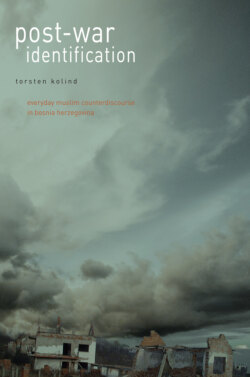Post-War Identification

Реклама. ООО «ЛитРес», ИНН: 7719571260.
Оглавление
Torsten Kolind. Post-War Identification
List of abbreviations
Acknowledgements
Part I. Framing the question. Prologue: Chronology of the war
The war in Herzegovina
The war in Stolac
The return
The public sphere in Stolac. Institutionally
Symbolically
Introduction
The structure of the book
The field
Chapter 1. Anthropological perspectives on war and war-related violence
Instrumentality/structure
Instrumentality
Structure
Expression
Experience/narrative
Experience
Narratives
Relevance to my study
Chapter 2. The unmaking of the world
The destruction of the everyday world
Leaving everything behind
Violence
Hunger
Anxiety about one’s family members
The destruction of stories
Am I me?
What do children play?
What is a school?
What is an enemy?
What is an ally?
You don’t kill children, do you?
You teach your children to be good, don’t you?
Normal people react to injustice, don’t they?
You trust friends and neighbours, don’t you?
Lamira’s story
The destruction of communication
Problems with forgetting
Problems with remembering: incomprehensibility
Problems with remembering: epistemology
Amputation: we ate grass
Amputation: losing weight
Amputation: film analogies
Amputation: rather die than go through it again
Amputation: this war was the worst
Amputation: hero-tales
The all-pervasive feeling of loss
Chapter 3. Remaking, identification, and counterdiscourse. Remaking
Officially sanctioned public spheres
Everyday life
Agency
Identification
Discourse
Constraining qualities of discourse
Reflection
The impossibility of discursive closure
Resistance
Counter
Culture
Authenticity
Consciousness
Part II. Who are they, the ones who did this to us? Introduction to Part II
Chapter 4. Yugoslav nationalism
The First Yugoslavia
The Second World War
The Tito era
From 1945 to 1980
After Tito: nationalism explodes
Milošović
Slovenia
Croatia
Bosnia Herzegovina
Nationalism for all
Resistance?
Chapter 5. Politika
Politika as a moral category
Politika as resistance
Politika as externalisation of the ungraspable
Politika as a way of analysing
Chapter 6. Pošteni ljudi – decency rather than ethnicity
Decency and moral disapproval
Džanana
People reveal their true nature during hard times
Decency and war-related behaviour
Explicit use of decency
Decency and the legitimisation of interethnic interaction
Decency and Muslim identity
Chapter 7. Nekultura – culture rather than ethnicity
The uncultured Other
The black market
‘The revenge of the countryside’
Nekultura as ethnic condemnation
Chapter 8. Complexity in ethnic categorisation as part of the counterdiscourse
Croats from central Bosnia
Croats from the countryside
Croats from Stolac
Croats from Croatia
Ethnic denunciations
HDZ
The church
‘Pure fascism’
Croat nature
Context-dependent condemnations
‘Good Croats’
Summary of Part II
Part III. Who are we, since this was done to us? Introduction to Part III
Chapter 9. The rise of Muslim national identity in Bosnia Herzegovina
The introduction of Islam
Austro-Hungarian rule and the emergence of a politicised ethnoreligious Muslim identity
The communist regime and the. secularisation of Muslim identity
The SDA and the emergence of Muslim nationalism in the post-Tito period
The war – Muslim nationalism escalates
Summary
Chapter 10. Bosnian Muslim identity in everyday practice
Pre-war Muslim identity in everyday life
Religion as ‘a domain of loose moral imperative’
Religion, a way to maintain difference
Ethnoreligious identity, one among many
The skill of living with ethnoreligious difference
The influence of war on Muslim everyday identity
Chapter 11. The national identity that failed
National identity. Nationalism versus survival
Bosnia has no appeal
Religious identity. Religiosity today
Dissociation from religious dogmatism
Chapter 12. Localistic identifications
The Stolac spirit
Coexistence
The beauty and economic strength of Stolac
The homemade and local
The struggle for local identity
Chapter 13. Ideal of tolerance and coexistence
The trouble-free past: a space uncontaminated by the war
The past as a political comment on the present
Tolerance and coexistence as sources of identity
The school in Stolac
Differences were an advantage
Nationality did not matter
Criticism of the Croats – identification of the Muslims
Coexistence is our fate
The merging of tolerance and Muslim identity
Chapter 14. The Balkans – Europe
The discursive construction of the Balkans – Europe. From without
From within
Balkan identifications in Stolac. Everyday Balkanism
Balkan, something in the air
Balkan, the authentic
Embracing Balkan insanity
European identifications in Stolac
Lagging behind Europe
We are Europeans, normal people
We are more European than you
Chapter 15. The role of the victim
The conspiracy
Criticism and decency – mosques and churches
We were not guilty
We did not destroy any churches
We did not commit any war crimes
We want to move on
Generational lopsidedness
Summary of Part III
Conclusion
Bibliography
Отрывок из книги
Post-War Identification
Everyday Muslim Counterdiscourse in Bosnia Herzegovina
.....
He suddenly stops talking, I can feel that he is moving towards the limit of where he still can talk and keep things at a distance. I say that it is impossible to understand how people can do such things to others. He answers that if you could, you would be like them.
According to Anvere, people’s and especially men’s attempts at forgetting are rather general, as she straightforwardly ascertained about her husband.
.....